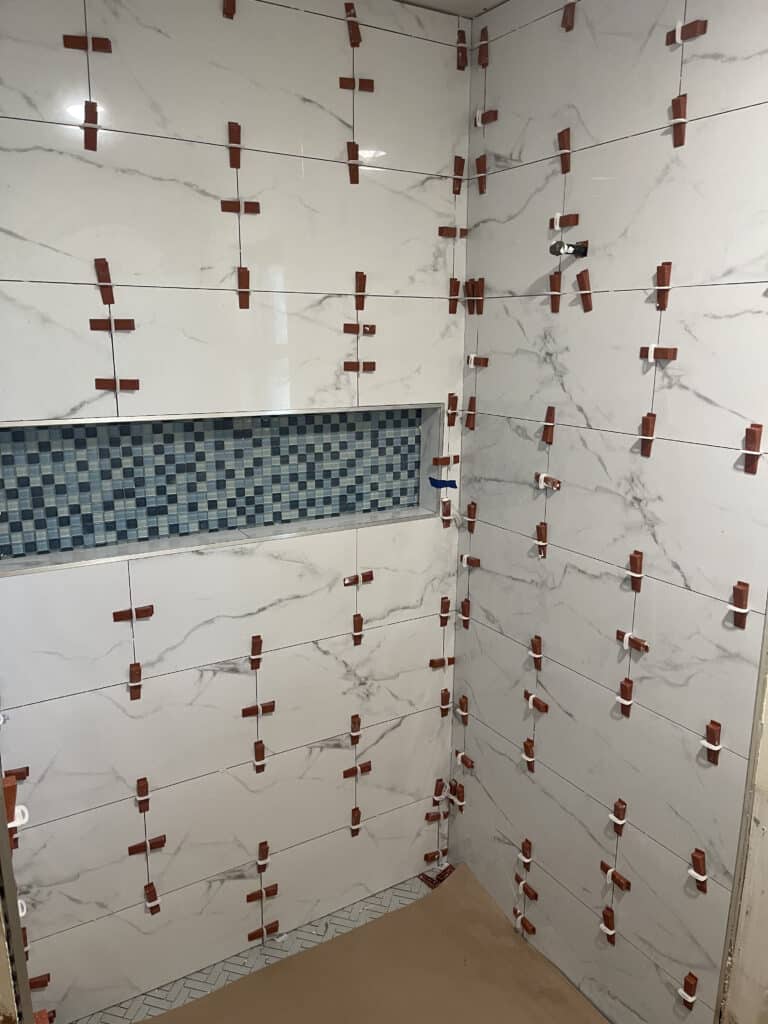
Tile Genie Hits the Track at the Kansas Lottery 300!
Tile Genie Hits the Track! This past weekend, Tile Genie traded trowels for tire tracks as we proudly sponsored the #14 car at the NASCAR

Tile is one of the best and most versatile materials you can choose for a bathroom remodel thanks to its moisture resistance, durability, low maintenance, and wide range of design options. It holds up well in wet environments, is easy to clean, and comes in a variety of styles and price points, from affordable options like luxury vinyl and terracotta to premium choices like quartz or porcelain. Whether you’re working with a tight budget or going all out with radiant floors and custom designs, there is a perfect tile for your project that can be tailored to suit your vision, space, and needs.
Choosing the right tile for your bathroom remodel can feel like a daunting task—but it doesn’t have to be. At The Tile Genie in Oklahoma City, we’re here to take the guesswork out of the process of tile projects with expert guidance that simplifies every step. From understanding material options and design possibilities to aligning with your budget and timeline, our specialists work with you to create a tailored plan that brings your vision to life. From upgrading a guest bath to transforming your primary suite, our mission is to deliver results that meet—or exceed—your expectations, every time.
When it comes to bathroom remodels, tile stands out as a smart, reliable choice as compared to materials like wood, laminate, or low-quality vinyl. Bathrooms are uniquely challenging, high-moisture environments, and many common materials simply don’t hold up, warping, staining, or wearing down over time.
Tile, on the other hand, offers a winning combination of resilience, style, and practicality, providing the performance and design flexibility that other materials often lack and making it a better long-term investment for your space. Using tile for your bathroom remodel helps address an array of variables, such as:
Frequent temperature changes. Bathrooms often shift from cool to steamy within minutes, especially during showers. Materials like wood or laminate can expand, contract, or warp with repeated temperature fluctuations. Tile is far more stable and resistant to these changes.
High foot traffic. Whether it’s a shared family bathroom or a frequently used guest bath, floors in bathrooms see a lot of use. Tile—especially porcelain and ceramic—holds up better under constant foot traffic and won’t wear down as quickly as vinyl or softer surfaces.
Slip risks. Wet floors are common in bathrooms, making slip resistance essential. Many tile options come with textured or matte finishes designed to reduce slipping—something that’s harder to achieve with materials like polished stone or laminate.
Cleaning and hygiene. Bathrooms require regular deep cleaning to stay sanitary. Tile is non-porous (or can be sealed to be), making it resistant to bacteria buildup, mold, and mildew. It’s easier to disinfect than grout-absorbing wood or carpeted bathroom mats.
Design constraints in small spaces. Bathrooms are often compact, so materials that allow for visual tricks—like large format tiles or light-colored finishes—can make the space feel bigger and brighter. Tile gives you more design flexibility to enhance both form and function.
Waterproofing and water resistance needs. Showers, tubs, and sinks are major sources of splashing and leaks. Unlike wood or untreated stone, tile can be part of a comprehensive waterproofing system, especially when installed with proper backing materials and sealants.
In addition to its moisture resistance, tile is a durable, long-lasting material that is easy to clean and care for, stands up to regular wear and tear, and is available in a wide variety of design and style options.
Before you dive into picking the perfect tile for your bathroom remodel, it’s important to take a step back and consider the bigger picture. While tile plays a major role in the final look and function of your space, choosing the right one depends on a few key decisions you’ll need to make first—like your overall goal, budget, design preferences, and where the tile will be installed. Clarifying these details upfront will help narrow your options and ensure the tile you choose truly fits your needs.
Knowing the goal of your remodel—whether it’s a simple refresh, a full upgrade, or increasing resale value—helps guide your tile choices toward options that best support that purpose. It ensures that both the style and functionality of your tile align with what you want your finished bathroom to accomplish.
Determining your budget before choosing tile helps you stay realistic about your options and avoid falling in love with materials that stretch your finances too thin. It also allows you to balance upfront costs with long-term value, such as durability and maintenance needs.
Knowing the aesthetic you want helps guide your tile selection so that colors, patterns, and materials all support the overall look and feel you’re aiming to achieve. Whether your style is modern and minimal, luxury and bold, or warm and rustic, having a clear design vision ensures your tile complements—not competes with—the rest of your space.
Knowing where you plan to install tile—whether on the floor, walls, shower, or backsplash—is key because not all tile types are suited for every location. Certain materials may be too slippery for floors or too heavy for walls, so placement helps determine the best options for both safety and performance.You may also want to consider mixing different tiles, with one type for the walls and another for the flooring.
When choosing tile for your bathroom remodel, you have many options. The most important choice in many projects is the material of the tile, which determines look, longevity, and cost.
Porcelain is a refined clay mixture and an all-around good choice for your bathroom remodeling project. It’s water-resistant, performs well in areas with high foot traffic, and offers a variety of style options. Porcelain does tend to be more expensive than some other tiles, but it’s a beautiful, durable material that is typically recommended for bathroom walls and floors.
Quartz tile is usually made from crushed quartz and other materials, including binding agents. It’s a human-made, non-porous stone tile that’s durable, easy to clean, resistant to liquids, and adds an elegant touch to your bathroom. Quartz can be slippery when wet and sensitive to certain cleaning chemicals, but its low maintenance and budget-friendly price point make it a great choice for bathroom walls and flooring.
Metal tiles come in a variety of types, including stainless steel, bronze, and aluminum. When properly coated, they resist water and corrosion. Metal tiles are also another durable tile and need only minimal maintenance. However, they can also be susceptible to scratches and dents, and some types cost more than others. Metal tiles are generally recommended for accent walls.
LVT is made from a combination of layers of polyvinyl chloride (PVC) and other materials. This results in a waterproof tile that’s also durable, able to handle high-traffic areas, and easy to install. In addition, LVT is a cost-effective option that comes in a variety of styles, including stone and wood looks. It’s best for bathroom flooring.
Stone mosaic is durable, anti-slip, easy to maintain, and liquid-resistant when sealed. However, the biggest selling point for stone mosaic tile is its look; it has a very natural, earthy style that comes in unique and interesting patterns that other tile types don’t. In terms of budget, it is a luxury option, and it’s ideal for accent walls, backsplashes, and shower floors.
Terracotta is another tile material with a unique look. It’s antibacterial and hygienic, able to withstand heavy foot traffic, and is moisture- and slip-resistant when properly sealed. The main appeal of terracotta is its rustic, earthy, red-orange appearance that adds warmth to any space. In terms of cost, terracotta tile can be slightly more expensive to install and maintain, but it’s highly durable and great for bathroom flooring and accent walls.
No matter the size of your budget, there’s a bathroom remodel tile project that can work for you. From affordable upgrades to full-scale luxury transformations, the right materials and design choices can bring your vision to life without breaking the bank. Partnering with a professional company like The Tile Genie helps you understand your options clearly, ensuring you make informed decisions that balance style, function, and cost.
You don’t have to tile your entire bathroom to give it an upgrade. Depending on your budget and needs, you might consider only upgrading your bathroom’s countertop, shower area, floor, or walls, including a feature wall. This is also a good way to test how well you like the tile and look over time before committing to a larger project.
Tile materials on the lower end of the cost scale such as luxury vinyl tile (LVT) and terracotta offer you the same benefits as other tiles without having to pay luxury prices. They’re still durable, water-resistant, and give you a wide range of styles to choose from. Using a more affordable type also means you can expand your project beyond just one part of your bathroom.
Mixing and matching different tiles, patterns, and materials lets you incorporate high-end elements without using them everywhere, helping you stay within budget. It also gives you creative flexibility to achieve a custom look while keeping costs manageable.
More complex–and even custom–designs, such as herringbone and chevron, require additional labor to install properly. This may mean additional cost, but the result is beautiful, unique, and worth the investment.
Installing an in-floor radiant heating system beneath the tile is an effective heating option, especially during the colder months of the year. It also ensures no more cold flooring, and because it’s hidden, it doesn’t affect the aesthetic of your bathroom.
Premium tiles like marble are a statement piece for any part of your home, including your bathroom. If you’re looking for a wow factor, tiles like these will instantly elevate your bathroom from everyday to exceptional.
A wet room allows for an open-concept shower because the entire room is waterproof. This requires proper drainage and sealing, but it creates a luxury experience you’ll enjoy for years to come.
At The Tile Genie, we simplify the process of selecting the perfect tile for your bathroom remodel project by offering personalized design consultations and expert guidance tailored to your vision, budget, and functional needs. Our experienced team can help you choose from a wide range of high-quality materials—like porcelain, ceramic, natural stone, and glass—ensuring your selection enhances both the look and durability of your space. From concept to completion, our full-service project management process keeps everything on track and on time, coordinating each step for a seamless, stress-free experience.
With The Tile Genie, your bathroom remodel becomes a smooth, spectacular, and beautiful transformation that’s built to last. Contact us today and let’s get to work.

Tile Genie Hits the Track! This past weekend, Tile Genie traded trowels for tire tracks as we proudly sponsored the #14 car at the NASCAR

The Tile Genie’s Proven Process for Perfect Tile Installation Professional tile installation is essential for achieving a beautiful, durable result that performs well over time.

Deciding between ceramic and porcelain tile for your next project comes down to understanding the unique strengths and limitations of each material. Ceramic tile is